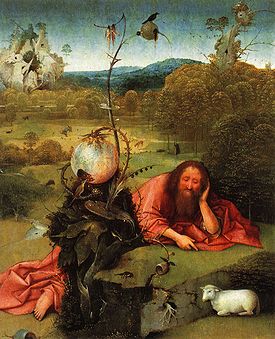- Matthew 3:4
-
 Hieronymus Bosch's St. John the Baptist
Hieronymus Bosch's St. John the Baptist
Matthew 3:4 is the fourth verse of the third chapter of the Gospel of Matthew in the New Testament. The verse occurs in the section introducing John the Baptist with this verse describing his clothing and diet.
In the King James Version of the Bible the text reads:
- And the same John had his raiment
- of camel's hair, and a leathern
- girdle about his loins; and his
- meat was locusts and wild honey.
The World English Bible translates the passage as:
- Now John himself wore clothing
- made of camel's hair, with a
- leather belt around his waist.
- His food was locusts and wild honey.
For a collection of other versions see BibRef Matthew 3:4
Nolland notes that the decision by the author of Matthew to give a description of John's clothing and diet shows that both are unusual and worth commenting on. That nowhere in the Gospel does the author give a description of Jesus' or his disciples clothing thus indicates that they did not adopt any form of atypical dress.[1]
This verse played an important role in the development of Christian monasticism with John the Baptist viewed as a model ascetic. The sparse food and uncomfortable clothing, including the wearing of hairshirts became seen as the ideal of Christian asceticism. John Calvin wholly rejected this interpretation. He did not see this verse presenting John the Baptist as an ideal, but rather presenting an accurate portrait of one forced to live in the wilderness. To Calvin John's holiness and popularity is not because of his asceticism but despite of it. Today most Protestants follow Calvin's view of this verse.[2]
The description of John the Baptist's clothing is believed by most scholars to be a deliberate echo that of the prophet Elijah who in 2 Kings 1:8 is said to wear "a garment of hair and with a leather belt around his waist."[3] Nolland notes that nowhere outside the Gospels is camel hair mentioned as being the clothing of an ascetic. The only reference to camel hair clothing he knows of is in the Apollonius paradoxographus, which speaks of a luxurious garment made of smooth camel hair. More common for the very poor would have been clothing made of goat hair.[4]
John the Baptist's diet has been the centre of much discussion. For many years it was traditional to interpret locust as referring to not the insect, but rather the seed pods of the carob tree. The two words are very similar, but most scholars today feel this passage is referring to the insects. Locusts are mentioned 22 other times in the Bible and all other mentions are quite clearly referring to the insect. Locusts are still commonly eaten in Arabia. Eaten either raw or roasted they are quite nutritious and a source of many vitamins. While most insects were considered unclean under Mosaic law Leviticus 11:22 specifically states that locusts are permitted. Albright and Mann believe the attempt to portray John the Baptist as eating seed pods was concern for having such a revered figure eating insects and also a belief that a true ascetic should be completely vegetarian.[5] What is meant by honey is also not undisputed. While bee honey was a common food in the area at the time, Jones believes that it refers to the tree gum from that tamarisk tree, a tasteless but nutritious liquid, rather than the honey made from bees.[6]
References
- ^ Nolland, John. The Gospel of Matthew: a commentary on the Greek text. Wm. B. Eerdmans Publishing, 2005 pg. 123
- ^ Calvin's commentary on Matthew 2:4
- ^ Albright, W.F. and C.S. Mann. "Matthew." The Anchor Bible Series. New York: Doubleday & Company, 1971.
- ^ Nolland, John. The Gospel of Matthew: a commentary on the Greek text. Wm. B. Eerdmans Publishing, 2005 pg. 139
- ^ Albright, W.F. and C.S. Mann. "Matthew." The Anchor Bible Series. New York: Doubleday & Company, 1971.
- ^ Jones, Alexander. The Gospel According to St. Matthew. London: Geoffrey Chapman, 1965.
Gospel of Matthew Preceded by:
Matthew 3:3Chapter 3 Followed by:
Matthew 3:5Categories: Gospel of Matthew verses | John the Baptist
Wikimedia Foundation. 2010.
